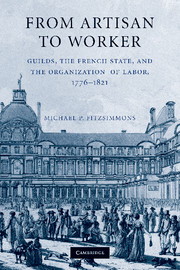4 - The Triumph of Mechanization, 1812–1821
Published online by Cambridge University Press: 06 July 2010
Summary
The king did not wish that honorable perseverance and new claims to national gratitude remain unrewarded. His Majesty has conferred the title of baron upon MM. Ternaux and Oberkampf, who have rendered, and continue to render, distinguished services to our industry.
Gazette Nationale, ou le Moniteur universel, December 6, 1819In January 1812, the government reorganized the Ministry of the Interior, removing the Second Division, which favored mechanized industry and opposed the reestablishment of guilds, and elevating it by creating a new ministry, the Ministry of Manufacturing and Commerce. From this larger platform, the new ministry continued to support mechanization of production and to stem any movement toward restoring corporations. In 1814, in an action that seemed to presage a rolling-back of revolutionary and Napoleonic reforms or policies, the restored Bourbon monarchy abolished the Ministry of Manufacturing and Commerce and reintegrated it into the Ministry of the Interior. Amid expectations that the Bourbon regime would reestablish guilds, which were perceived as a quintessential monarchical institution, a pamphlet debate began on that issue. The monarchy temporized, but in 1819 the Ministry of the Interior revived the industrial exhibition, thereby signaling its endorsement of mechanization over the reestablishment of guilds.
THE CREATION OF THE MINISTRY OF MANUFACTURING AND COMMERCE
A decree of January 19, 1812, had created the Ministry of Manufacturing and Commerce, with a mandate to manage all internal and external trade, as well as the formation and administration of the manufacture of “indigenous products.”
- Type
- Chapter
- Information
- From Artisan to WorkerGuilds, the French State, and the Organization of Labor, 1776–1821, pp. 189 - 255Publisher: Cambridge University PressPrint publication year: 2010



